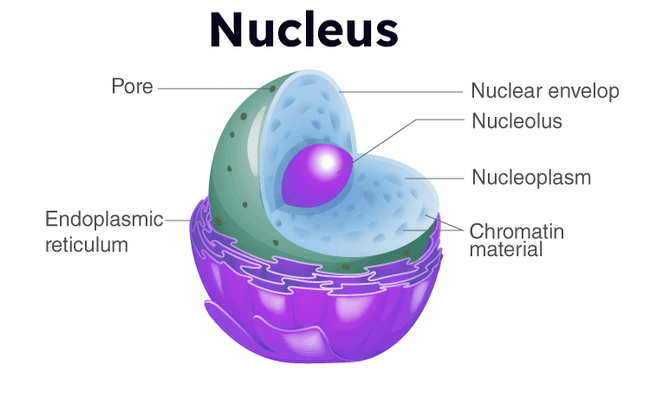What is Nucleus?

Different Parts of Nucleus and Their Functions:
Various structures found in the nucleus-
- Nuclear membrane or nuclear envelope,
- Chromatin,
- Nucleolus,
- Nuclear pore,
- Nucleoplasm.
1. Nuclear Membrane:
The nucleus is enclosed by a nuclear envelope, which is made up of two layers of the membrane: an outer membrane and an inner membrane. Each of these membranes contains two layers of phospholipids, organized with their tails pointing inward (forming a phospholipid bilayer). Between the two layers of the nuclear envelope has some thin space is called perinuclear space (20-40 nm wide) and this space is directly connected to the rough endoplasmic reticulum(ER). The envelope is perforated with tiny holes called nuclear pores and these pores allow content to move in and out of the nucleus. The inner surface of the nucleus has a protein lining called the nuclear lamina and which binds to chromatin and other nuclear components.
Some key functions of the nuclear membrane have listed in the following:
- It separates the nucleus from the cytoplasm.
- The nuclear pore provides pathways between the nucleus and the cytoplasm.
- During mitosis, or cell division, the nuclear envelope breakdown.
- Nuclear membrane reforms as the two cells complete their formation and the chromatin begins to unravel and disperse.
- The nuclear membrane protects genetic information from mixing with other parts of the cell.
What is Nuclear Pore?
Nuclear pores are protein-based channels in the nuclear envelope. They are minute opening or passageway through the nuclear envelope.
All the functions of nuclear pore have described the below:
- The nuclear pore is considered to be the gatekeeper of the nucleus and facilitates almost all transport between the nucleoplasm and the cytoplasm.
- They regulate the movement of molecules from the nucleus to the cytoplasm and vice versa.
- They connect the nucleoplasm (nucleus) with the cytoplasm.
- They provide access to the nucleus and regulate the transport of proteins and RNA across the nuclear envelope.
What Is Chromatin?
When a cell is “resting” i.e. not dividing (interphase nucleus), the chromosomes are organized into long entangled structures and elaborate with dense string-like nucleoprotein fibers called chromatin. They are composed of DNA and basic proteins (histones). The fundamental structural unit of chromatin is the nucleosome.
Some key functions of chromatin have listed in the following:
- Chromatin carries most of the genetic information of the cell.
- Synthesize the mRNA, rRNA, and tRNA as well as their precursor.
- Chromatins efficiently pack DNA into a small volume to fit into the nucleus of a cell and protect the DNA structure and sequence.
- Packaging DNA into chromatin allows for cell division (mitosis and meiosis).
- Chromatin helps to prevent chromosomal breakage and controls gene expression and DNA replication.
- Sex chromatin permits the determination of genetic sex.
What is Nucleolus?
The nucleolus is a spherical separate structure within the nucleus consisting largely of rRNA and protein. The nucleolus is not covered by a membrane, it is a densely stained component found in the nucleus. It presents in the Centre of the nucleus. Through the Electron Microscope, the nucleolus looks like a large dark spot within the nucleus. A nucleus may contain up to four nucleoli, but within each species, the number of nucleoli is fixed.
All the functions of the nucleolus have mentioned below:
- The key function of the nucleolus is to rewrite ribosomal RNA (rRNA) and combine it with proteins.
- Ribosomal RNA (structural component of ribosomes) is synthesized in the nucleolus.
- It helps in protein synthesis.
What is Nucleoplasm?
Nucleoplasm is a highly gelatinous, sticky substance within the nuclear envelope. It is surrounded by the nuclear envelope or nuclear membrane. Nucleoplasm acts as protoplasm, similar to the cytoplasm that can be found throughout the cell body outside the nucleus. Nucleoplasm is composed mostly of water, a mixture of various molecules, and dissolved ions that support the chromosomes and nucleoli.
Some key functions of nucleoplasm have pointed out in the following:
- Gives information about the functional activity of the cell.
- It acts as enzymatic activity of the cell.
- Nucleoplasm also helps maintain the shape and structure of the nucleus.
- It plays an important role in the transportation of materials that are vital to cell metabolism and function.
- Many other substances such as nucleotides and enzymes are dissolved in the nucleoplasm.

Maria Khatun Mona is a Founder and Editor of Nursing Exercise Blog. She is a Nursing and Midwifery Expert. Currently she is working as a “Senior Staff Nurse” at “Dinajpur Medical College Hospital”, Bangladesh. She has great passion in writing different articles on Nursing and Midwifery. Mail her at “maria.mona023@gmail.com”
